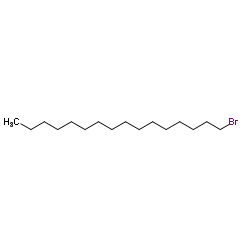1-Bromohexadecane

1-Bromohexadecane structure
|
Common Name | 1-Bromohexadecane | ||
|---|---|---|---|---|
| CAS Number | 112-82-3 | Molecular Weight | 305.337 | |
| Density | 1.0±0.1 g/cm3 | Boiling Point | 335.5±5.0 °C at 760 mmHg | |
| Molecular Formula | C16H33Br | Melting Point | 16-18 °C(lit.) | |
| MSDS | Chinese USA | Flash Point | 139.8±10.5 °C | |
| Symbol |

GHS07 |
Signal Word | Warning | |
|
Change of surface structure upon foam film formation.
ChemPhysChem 16(4) , 733-8, (2015) The charge distribution and coverage with surfactant molecules at foam film surfaces plays an important role in determining foam film structure and stability. This work uses the concentration depth profiling technique neutral impact collision ion scattering s... |
|
|
Reversible deformation-formation of a multistimuli responsive vesicle by a supramolecular peptide amphiphile.
Soft Matter 11 , 4912-20, (2015) A systematic study of the ternary complex formation process for aromatic amino acids using ucurbit[8]uril (CB[8]) and a viologen amphiphile shows that the affinity of the amino acid needs to be higher or in a comparable range to that of CB[8] for the amphiphi... |
|
|
Cationic lipid-conjugated hydrocortisone as selective antitumor agent.
Eur. J. Med. Chem. 108 , 309-21, (2016) Hydrocortisone, the endogenously expressed steroidal, hormonal ligand for glucocorticoid receptor (GR), is body's natural anti-inflammatory and xenobiotic metabolizing agent. It has both palliative as well as adverse effects in different cancer patients. Here... |
|
|
Dual self-sorting by cucurbit[8]uril to transform a mixed micelle to vesicle.
Langmuir 30(39) , 11528-34, (2014) A systematic study on the cucurbit[8]uril (CB[8]) assisted transformation of a mixed micellar system of CTAB and a viologen surfactant to vesicles is depicted. The micelle to vesicle transformation is assisted by a charge transfer complex mediated ternary com... |
|
|
Determination of endocrine-disrupting phenols in water samples by a new manual shaking-enhanced, ultrasound-assisted emulsification microextraction method.
J. Colloid. Interface Sci. 333(1) , 40-8, (2009) Manual shaking-enhanced, ultrasound-assisted emulsification microextraction (MS-USAEME) combined with ultraperformance liquid chromatography (UPLC) with UV detection has been developed for the determination of five endocrine-disrupting phenols (EDPs) in seawa... |
|
|
Preparation and characterization of soluble carbon nano-onions by covalent functionalization, employing a Na-K alloy.
Chem. Commun. (Camb.) 49(24) , 2406-8, (2013) Herein we report the preparation of truly soluble CNOs by covalent functionalization with hexadecyl chains. These compounds are prepared in two steps: first, reduction of CNOs with a Na-K alloy in 1,2-DME under vacuum, followed by nucleophilic substitution em... |
|
|
Synthesis and properties of N-hexadecyl ethylenediamine triacetic acid.
J. Colloid. Interface Sci. 279(2) , 548-51, (2004) A new kind of surfactant named N-hexadecyl ethylenediamine triacetic acid (HED3A) was synthesized from anhydrous ethylenediamine, 1-bromohexadecane, and chloroacetic acid. Testing showed stability of HED3A in hard water, wetting power, dispersing power, and s... |
|
|
A method for estimating effective coalescence rates during emulsification from oil transfer experiments.
J. Colloid. Interface Sci. 374(1) , 25-33, (2012) The Oil Transfer Technique (OTT) was developed by Taisne et al. [1] to measure coalescence during emulsification and has been applied since in several studies. One of the main drawbacks of this technique is that it only gives a qualitative measure of coalesce... |
|
|
Physical-chemical and solvent considerations in evaluating the influence of carbon chain length on the skin sensitization activity of 1-bromoalkanes.
Toxicol. Sci. 107(1) , 78-84, (2009) The murine local lymph node assay (LLNA) is an internationally accepted assay for identification of contact allergens. The LLNA has also been used in research studies to evaluate contact allergen potency, as well as chemical structural-allergenic activity rel... |
|
|
NMR Q-space microscopy of concentrated oil-in-water emulsions.
Magn. Reson. Imaging 18(3) , 319-33, (2000) The pulsed field gradient stimulated echo technique with selective excitation is used to probe the diffusion of water in the continuous phase of concentrated oil-in-water emulsions. The dependence of the echo amplitude, S(q,Delta), on wavevector, q, and diffu... |